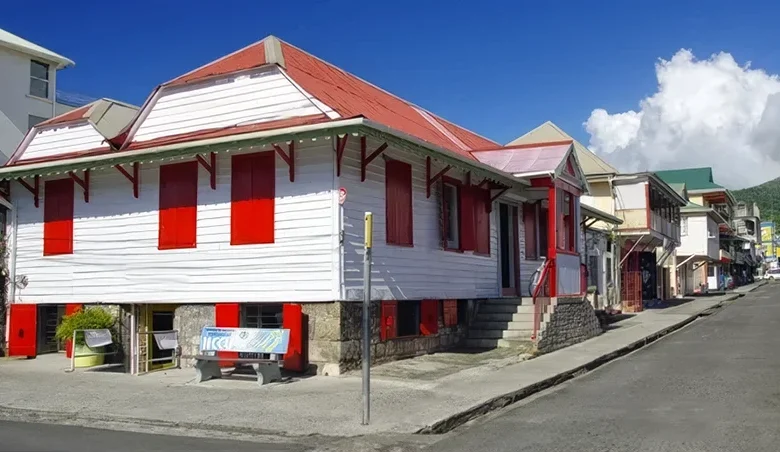Dominica’s Architectural Landscape

Dominica’s architectural landscape offers a rich blend of historical influences, indigenous styles, and modern sustainable designs, reflecting the island’s unique history and environment. Dubbed the Nature Isle of the Caribbean, Dominica has long embraced its indigenous Kalinago roots while preserving its French and British colonial legacies. Today, the capital city, Roseau, embodies this fusion of cultural influences, showcasing everything from traditional wooden homes to stately Georgian-inspired buildings and new eco-friendly constructions.
Colonial Influences: French and British Architecture
French and British influences shape Dominica’s early colonial architecture. Structures combine practical designs suited to the island’s tropical climate with aesthetics borrowed from European styles. French settlers introduced vital elements, including steeply pitched roofs, large windows for ventilation, and wooden facades. These features remain visible in Roseau, particularly along King George V Street, where many French-inspired homes and commercial buildings blend function and style.
For example, the Barracoon Building in Roseau reflects French colonial architecture’s simple yet robust features. Meanwhile, the Roman Catholic Cathedral in Roseau showcases Neo-Gothic architecture introduced by French Catholic missionaries, with its vaulted ceilings and elaborate stonework.
British colonization added a new dimension to Dominica’s architectural landscape, introducing Georgian-style designs characterized by symmetry, large windows, and wooden shutters. The Anglican Church in Roseau is one of the most prominent examples, featuring an imposing stone structure with classic Georgian lines and arches. Many public buildings constructed under British rule still stand in Portsmouth, a testament to the British architectural legacy on the island.
Traditional Vernacular Architecture: The Ti Kai
Dominica’s architectural legacy is not solely European; the island’s traditional wooden houses, known as ti Kais, showcase the ingenuity of the island’s African and Indigenous communities. The ti kai, a small house built on stilts, was designed to withstand the island’s harsh weather conditions, including hurricanes and heavy rains. Key features include raised wooden foundations, jalousie shutters, and high-pitched roofs for natural ventilation. The Kalinago people influenced the design of these homes, adapting their knowledge of local materials and climate.
Examples of ti kais can still be found throughout Dominica’s rural areas, where they remain a common architectural style, especially in the Kalinago Territory. These homes embody resilience and adaptability, reflecting African influences, including elements introduced by enslaved Africans who brought with them traditional building knowledge.
Modern and Sustainable Architecture
In recent years, Dominica has seen a wave of modern and sustainable architecture. The government and private sector have increasingly focused on eco-friendly buildings that use renewable materials and energy sources. One prime example is the newly planned international airport project, set to open by 2026, incorporating green building practices designed to reduce its carbon footprint.
Beyond large-scale projects, modern residential and commercial buildings in Roseau and Portsmouth integrate solar panels, rainwater harvesting systems, and natural ventilation to create comfortable yet sustainable spaces. The eco-conscious design reflects Dominica’s commitment to conservation and aligns with the island’s goal of becoming the world’s first climate-resilient nation.
Preservation Efforts: SHAPE and Heritage Conservation
Preservation efforts on the island are led by the Society for Heritage Architecture Preservation and Enhancement (SHAPE), an organization dedicated to conserving Dominica’s historic buildings. Founded to address the increasing loss of architectural heritage due to natural disasters and modernization, SHAPE works to restore significant historical sites and promote awareness about the importance of preservation.
One of SHAPE’s notable projects is restoring the Barracoon Building, which has deep historical significance as it was once used as a holding area for enslaved Africans. SHAPE also plays a critical role in educating local communities about the cultural value of historic structures and encouraging efforts to maintain and protect traditional buildings, like the ti Kais, from decay.
Future of Dominica’s Architecture
Dominica’s future architecture will be based on balancing modernity with tradition. As the country moves towards becoming a climate-resilient nation, sustainable architecture will play a critical role. Projects like the international airport and new eco-resorts set a precedent for environmentally conscious building practices. Meanwhile, efforts to preserve the island’s colonial structures and Indigenous architectural styles focus on the importance of honouring Dominica’s diverse history.




